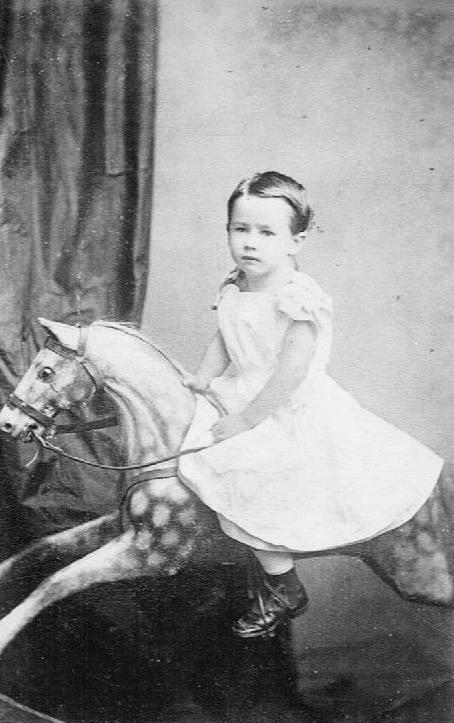
English Boys' Dresses: Stylistic Elements--Sleeves

Figure 1.--This CDV portrait shows an unidentified English boy on a wonderful period rocking horse. The side hair part identifis him as a boy which is also suggested by the rocking horse. He looks to be about 3- years old. Notice the neckline, not low, but open. The dress has balloon sleeves. Notice the leading string boiws on the sleeves. He also wears a plain petticoat. Also notice the white long stockings and high-top shoes. The portrait is not dated, but we would guess was taken in the 1870s, becaise of the plain background and rounded mount corners. The photographer was Mrs. Williams Studio in Wolverhanpton. Most photogrphers were men, but there were a few intrepid women like Mrs. Williams. They often specialized in children.
|
|
The sleeves begin at the shoulders. There were various ways to deal with sleeves. Dress designers experimented with the various options. And thus shoulder treatment varied considerably. We do not think that there were any gender connotations here, at least in the early- and mid-19th century. This may have changed in the late-19th century as the convention of boys wearing dresses began to go out of style. Balloon or puff shoulders were very popular for children's dresses. And at times were employed for women's dresses. There were also plain shoulders and sleeveless dresses. The sleeves were done in different lengths, basically short, elbow, forearm, and long. Here seasonality is a factor. The sleeveless and shorter lengths are popular for the summer while the longer lengths are used more for winterwear. The width of the sleeves also vary. They are done as narrow, wide, and full. Sleeve trends also varied chronologically. We see very wide sleeves in the mid-19th century. We see huge balloon sleeves popular for women in the 1890s. We do not yet have a large enough archive to develop these trends, but hope to eventually do so.
Gender Conotations
We do not think that there were any gender connotations to the sleeves. This appears to have been the case for as long as dreses were worn by younger boys which means for several centuries. And as far as we can tell through the mid-19th century. We can see that here (figure 1). The child is clearly a boy, given the side part and toyboat as well as being pictured on a hobby house. Here, at least in the early- and mid-19th century we can see a boying wearing a dress that could just as easily be worn by his sister. This may have changed in the late-19th century as the convention of boys wearing dresses began to go out of style.
Leading String
Dresses for younger children in the 17th, 18th, and early 19th century were donr with leading strings. This was to assist younger toddlers learn to walk. It helped support the child's first steps. Notice the bows on the boy's sleeves here (figure 1). They are a fashion residual of the long tradition of leading strings.
The sleeves are the part of a garment that covers the arm or part of the arm. The arms passes or slipsthrough it, although in the shorter version very little of the arms are covered. The sleeves begin at the shoulders. There were various ways to deal with sleeves. Dress designers experimented with the various options. And thus shoulder treatment varied considerably. There were several different types of sleeves. There were various styles of sleeveless dresses. Most sleeves were done somewhere between the mid-upper arm and the wrist. Balloon or puff shoulders were very popular for children's dresses. The boy here has puff sleeves (figure 1). They were generally very short, but there were variations over time. This was a style very popular for younger children, but was at times also employed for women's dresses. There were also plain shoulders and sleeveless dresses. The sleeves were done in different lengths, basically short, elbow, forearm, and long. Here seasonality could be an important factor. The sleeveless and shorter lengths are popular for the summer while the longer lengths are used more for winterwear. The width of the sleeves also vary. They are done as narrow, wide, and full. Sleeve trends also varied chronologically. We see very wide sleeves in the mid-19th century. We see huge balloon sleeves popular for women in the 1890s. We do not yet have a large enough archive to develop these trends, but hope to eventually do so.
HBC

Navigate the Boys' Historical Clothing Web Site:
[Return to the Main English stylistic elements dress page]
[Return to the Main national dress page]
[Introduction]
[Activities]
[Biographies]
[Chronology]
[Clothing styles]
[Countries]
[Essays]
[Bibliographies]
[Contributions]
[FAQs]
[Glossary]
[Images]
[Links]
[Registration]
[Tools]
[Boys' Clothing Home]
Created: 11:49 PM 3/19/2015
Last updated: 5:16 AM 6/15/2019



